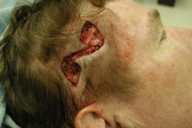Burow's advancement flap closure of adjacent defects
Published Web Location
https://doi.org/10.5070/D31520536dMain Content
Burow's advancement flap closure of adjacent defects
Brandie J Metz MD, and Rajani Katta MD
Dermatology Online Journal 11 (1): 11
Department of Dermatology, Baylor College of Medicine, Houston, TX. rkatta@bcm.tmc.edu
Abstract
When two surgical defects are closely approximated, primary closure may be difficult because of tension on the tissue between the defects. We outline a technique using a Burow's-triangle advancement flap in which the advanced Burow's triangle contains the second defect. The defects are easily closed with a single flap that utilized the second defect. This flap is useful when there are two closely approximated surgical defects of which primary closure is limited by tension on the tissue between the defects.
Introduction
When two surgical defects are closely approximated, primary closure may be difficult as a result of excessive tension on the tissue between the two defects. In such cases it is possible to close both defects with a Burow's triangle advancement flap in which the advanced Burow's triangle contains the second defect. Although the resulting suture line is longer than the sum of the two elliptical excisions, the resulting Z-shaped incision decreases the tension between the lesions and may be more cosmetically acceptable [1].
A Burow's-triangle advancement flap is intended as a means to move the Burow's triangle to a more desirable location. This is usually performed to avoid crossing an aesthetic boundary or to conceal an incision line in a less conspicuous location [2]. In this case, the Burow's triangle is advanced to a location where a second defect already exists.
Methods and results
A 68-year-old man presented for excision of an 8-mm basal cell carcinoma on the right temporal scalp. At the time of excision a second 8-mm pearly papule was noted on the temporal scalp 2-cm anterior to the first lesion. Both lesions were excised simultaneously, resulting in two 1.6-cm defects with 1.5 cm of tissue remaining between the defects (Fig. 1).
A Burow's advancement flap was performed so that the secondary triangle, the so-called "Burow's wedge", contained the second lesion (Fig. 2).

|

|
| Figure 3 | Figure 4 |
|---|---|
| After undermining, each flap is advanced into the defect (Fig. 3). | |
| Final closure with Z-shaped suture line (Fig. 4). | |
After appropriate undermining, the flaps were approximated with intradermal sutures (Fig. 3) and final closure obtained with running simple sutures, resulting in a final Z-shaped suture line (Fig. 4). These lesions were excised in a setting where Mohs micrographic surgery was available on a limited basis. It would, of course, be ideal to excise adjacent lesions by Mohs micrographic surgery to ensure negative margins prior to performing such a flap in order to prevent recurrences in unexpected sites.
References
1. Boggio P, Gattoni M, Zanetta R, Leigheb G. Burow's triangle advancement flaps for excision of two closely approximated skin lesions. Dermatol Surg 1999;25:622-625. PubMed2. Gormley DE. A brief analysis of the Burow's wedge/triangle principle. J Dermatol Surg Oncol 1985; 11 (2): 121-123. PubMed
© 2005 Dermatology Online Journal



